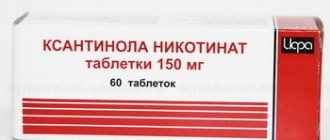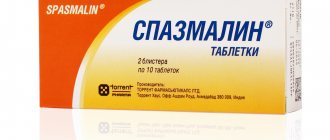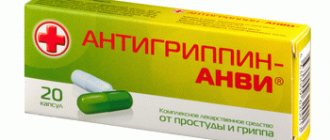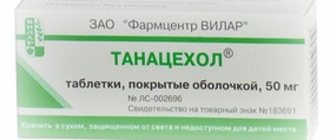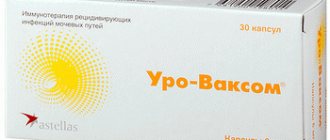The drug Dipyridamole, which is produced in Spain, is an antiaggregation agent. The key active ingredient is dipyridamole, which prevents the formation of platelets, enhances blood microcirculation and promotes vasodilation. A medication is prescribed in case of cerebral blood flow disorders, as a prophylaxis for placental insufficiency and venous/arterial thrombosis.
Release form and composition
Dosage forms:
- Film-coated tablets (10 pieces each in a blister pack, in a cardboard box: 25 and 50 mg - 5 or 10 packs, 75 mg - 4 or 10 packs);
- Suspension for oral administration: bright yellow liquid with a characteristic odor of almonds (150 ml in orange glass bottles (type III), 1 bottle in a cardboard box).
Active substance – dipyridamole:
- 1 tablet – 25, 50 or 75 mg;
- 5 ml of suspension – 50 mg.
Suspension excipients: ammonium glycyrrhizinate, aluminum magnesium silicate, propylene glycol (E1520), polysorbate 80, liquid maltitol (E965), anhydrous sodium hydrogen orthophosphate (E339), citric acid monohydrate solution 5%, simethicone emulsion 30% (Q7-2587), levomenthol , methyl parahydroxybenzoate (E218), sodium hydrogen orthophosphate anhydrous solution 5%, propyl parahydroxybenzoate (E216), xanthan gum (E415), Almond flavor (F31209) (contains propylene glycol and ethanol), citric acid monohydrate (E330), purified water.
Pharmacological properties
Pharmacodynamics
Dipyridamole improves microcirculation, inhibits platelet aggregation and adhesion, and has a mild vasodilator effect.
The mechanism of the inhibitory effect of dipyridamole on platelet aggregation is associated with the suppression of the reuptake of adenosine (an inhibitor of platelet reactivity) by erythrocytes, platelets and endothelial cells, as well as with the inhibition of platelet phosphodiesterases and activation of adenylate cyclase. Thus, the drug prevents the release of aggregation activators from platelets, including serotonin, adenosine diphosphate (ADP), thromboxane (TxA2). Dipyridamole increases the synthesis of prostacyclin PgI2 by the endothelium of the vascular wall. By preventing platelet aggregation, it normalizes the ratio of PgI2 and TxA2. Enhances the synthesis of endothelial nitric oxide (N0). Reduces platelet adhesiveness, stabilizes blood flow in the ischemic area, and prevents the formation of blood clots in blood vessels.
Dipyridamole has a dose-dependent ability to prolong the pathologically shortened platelet life time.
Thanks to its vasodilating effect, the drug reduces general and peripheral vascular resistance, improves microcirculation, and has angioprotective properties. These effects are explained by increased activity of endogenous adenosine, which affects vascular smooth muscle and prevents the release of norepinephrine.
Dipyridamole has angiogenic and arteriogenic activity, stimulates the formation of new capillaries and collateral arteries.
The drug normalizes venous outflow and reduces the incidence of deep vein thrombosis after surgery. Improves microcirculation in the renal glomeruli and retina.
The effects of dipyridamole, such as improving cerebral circulation and reducing cerebral vascular tone, are used in neurological practice. In the course of angiographic studies, it was found that the use of the combination “dipyridamole + acetylsalicylic acid” can slow down the progression of atherosclerosis.
In obstetric practice, the drug is used to improve placental blood flow, eliminate hypoxia of fetal tissues and the accumulation of glycogen in them, and prevent degenerative changes in the placenta.
Pharmacokinetics
After oral administration, dipyridamole is rapidly absorbed from the gastrointestinal tract: mainly in the stomach, to a lesser extent in the small intestine. The biological availability of the drug varies from 37 to 66%.
Dip0-iridamole reaches its maximum concentration in plasma within 2 hours. It is almost completely bound to plasma proteins (80–95%). Metabolized in the liver by binding to glucuronic acid. It is excreted primarily into bile and excreted through the intestines as a monoglucuronide. A small amount (1–3%) is excreted by the kidneys.
The decrease in plasma concentration of the drug is biphasic. The half-life of dipyridamole in the initial phase is 20–30 minutes, the final elimination phase is 10–12 hours.
Pharmacodynamics and pharmacokinetics
The set of chemical and biological properties of the drug allows it to be used as a therapeutic or prophylactic agent. The main purpose of taking the medicine is to combat congestion in tissues and blood channels, prevent ischemia, and eliminate the consequences of hypoxia. The product can also help with diagnosing coronary heart disease.
Results of using the drug:
- expansion of the coronary vessels, leading to an increase in the volume of blood passing through the channels;
- increasing the oxygen content in venous blood in certain parts of the heart, providing active nutrition to muscle tissue;
- reducing vascular resistance, improving microcirculation in problem areas;
- preventing active platelet aggregation, preventing the formation of blood clots, preventing deterioration of blood flow in areas with ischemia;
- stimulation of delayed interferon synthesis, strengthening the body's defense against viral infections;
- normalization of venous outflow, prevention of blockage of deep veins by blood clots;
- decreased tone of the walls of cerebral vessels, which is pathologically increased in certain types of cerebral circulatory failure.
The bioavailability of the active substance ranges from 37 to 66%. The component binds to blood plasma proteins by 80-95%. Regardless of its type, dipyridamole quickly penetrates the organs. Its maximum concentration is recorded an hour after application. Oral forms are absorbed in the stomach and partially in the small intestine. It is destroyed in the liver, the results of metabolism are excreted in bile. When liver performance decreases, the main component may accumulate in body tissues.
Indications for use
- Prevention and treatment of ischemic cerebral circulatory disorders;
- Encephalopathy;
- Prevention of venous and arterial thrombosis and their complications;
- Prevention of thromboembolism after heart valve replacement surgery;
- As part of a complex treatment of all types of microcirculation disorders;
- Prevention and treatment of acute respiratory viral infections (ARVI), influenza, as an immunomodulator and interferon inducer (tablets only).
In addition, Dipyridamole tablets are used in complicated pregnancies to prevent placental insufficiency.
Compatibility of “Dipyridamole” with other drugs
It is important to consider that this drug is often prescribed as part of complex therapy. For this reason, the compatibility of dipyridamole with other medications is taken into account.
- With antihypertensive drugs. The effect of these drugs is enhanced.
- With acetylsalicylic acid. The drugs enhance each other's effects.
- With antacids. In this case, the effectiveness of dipyridamole is reduced.
- With cephalosporin antibiotics. These drugs increase the antiplatelet effect.
- With adenosine. When taken together, an enhanced cardiovascular effect occurs, so dosage adjustment may be required.
- With cholinesterase inhibitors, their effect is reduced, which leads to increased manifestations of myasthenia gravis.
- With xanthine derivatives. Caffeine, theophylline and other elements of this group partially neutralize the vasodilator effect.
Contraindications
- subaortic stenosis;
- widespread stenotic atherosclerosis of the coronary arteries;
- unstable angina;
- hypertrophic obstructive cardiomyopathy;
- severe heart rhythm disturbances;
- decompensated heart failure;
- severe arterial hypotension;
- severe arterial hypertension;
- collapse;
- acute myocardial infarction;
- liver/renal failure;
- hemorrhagic diathesis;
- diseases with a tendency to bleeding (for example, peptic ulcer of the stomach or duodenum);
- chronic obstructive pulmonary disease;
- hypersensitivity to any component of the drug.
Additional contraindications to the use of tablets are:
- lactose intolerance, glucose-galactose malabsorption syndrome, lactase deficiency;
- children's age up to 12 years.
Additional contraindications to the use of the suspension are:
- fructose intolerance;
- age up to 18 years.
According to the instructions, Dipyridamole should be used with caution in the following cases:
- bleeding disorders;
- elderly age;
- period of pregnancy and lactation.
Analogs
Dipyridamole has analogues. But, replacing a prescribed drug on your own can be dangerous to your health; prior consultation with your doctor is required.
Chime
The drug is characterized by immunomodulatory, angioprotective and antiplatelet effects. In fact, it is not used in pediatric practice, but can be prescribed to children from 12 years of age.
Instructions for use of Dipyridamole: method and dosage
Film-coated tablets
In tablet form, Dipyridamole should be taken orally on an empty stomach, swallowed whole and washed down with plenty of water.
The optimal dosage regimen and duration of treatment are selected by the doctor individually depending on the indications, the severity of the disease and the patient’s response to therapy.
Individual cases of dosing of the drug:
- prevention and treatment of cerebrovascular accidents: 75 mg 3 to 6 times a day (daily dose is 225–450 mg);
- coronary heart disease: 75 mg 3 times a day, increase the dose if necessary, treatment is accompanied by careful medical supervision;
- reduction of platelet aggregation: the daily dose can vary in the range of 75–225 mg, in severe cases it is possible to increase the daily dose to the maximum allowable - 600 mg;
- prevention of placental insufficiency: 25 or 75 mg 3 times a day. The maximum permissible daily dose of Dipyridamole during pregnancy is 225 mg;
- prevention of influenza and acute respiratory viral infections: 50 mg 1 time every 7 days for 4–5 weeks (during the epidemic);
- prevention of relapses of ARVI in frequently ill patients: 50 mg 2 times a day with a 2-hour interval once a week for 8–10 weeks.
The duration of taking the drug is individual. Dipyridamole can be used long-term.
Oral suspension
The suspension is taken orally 1 hour before meals. It is recommended to shake the contents of the bottle before each dose.
Dosage is prescribed by the attending physician individually depending on the clinical indications, the severity of the patient’s condition and his response to treatment. Recommended daily dosage:
- reduction of platelet aggregation: 100 mg (2 teaspoons) 3 times a day, for severe cases the daily dose may be increased to 600 mg;
- prevention of influenza and other acute respiratory viral infections (most relevant during the epidemiological period): 50 mg (1 teaspoon) once a week, course duration - 4-5 weeks;
- prevention of relapses in patients who often suffer from viral respiratory infections: 100 mg (2 teaspoons) 2 times a day, 1 time per week, duration – 8-10 weeks.
Instructions:
Clinical and pharmacological group
01.065 (Antiplatelet agent. Myotropic vasodilator)
Release form, composition and packaging
The suspension for oral administration is bright yellow in color, with a characteristic odor of almonds.
| 1 ml | 5 ml | |
| dipyridamole | 10 mg | 50 mg |
Excipients: magnesium aluminum silicate, citric acid monohydrate, polysorbate 80, sodium hydrogen phosphate anhydrous, ammonium glycyrrhizinate, simethicone emulsion 30% (Q7-2587), liquid maltitol, propylene glycol, methyl parahydroxybenzoate, propyl parahydroxybenzoate, levomenthol, Almond flavor (F31209) (contains ethanol and propylene glycol), xanthan gum, anhydrous sodium hydrogen phosphate solution 5%, citric acid monohydrate solution 5%, purified water.
150 ml - bottles (1) - cardboard packs.
pharmachologic effect
Dipyridamole dilates the coronary vessels (mainly arterioles) and causes a significant increase in the volumetric velocity of blood flow. Increases the oxygen content in the venous blood of the coronary sinus and its absorption by the myocardium. Promotes the development of collateral coronary circulation, reduces total peripheral vascular resistance, improves microcirculation, and has an angioprotective effect. These effects are due to increased activity of endogenous adenosine by reducing its uptake by tissues and destruction (adenosine affects vascular smooth muscle and prevents the release of norepinephrine. It is an antagonist of the endogenous adenosine diphosphate (ADP) aggregant, inhibits phosphodiesterase, while reducing the release of aggregation activators from platelets - thromboxane, ADP, serotonin, etc., increases the synthesis of prostacyclin PgI2 by the endothelium of vascular tissue, which prevents platelet aggregation. Reduces platelet adhesiveness, prevents the formation of blood clots in blood vessels and a decrease in blood flow in the ischemic area. The antiplatelet effect occurs at a plasma concentration of 0.1 μg/ml; dose-dependently lengthens pathologically shortened platelet lifespan. Dilates coronary arteries, especially unchanged ones, causes the steal phenomenon. Is an interferon inducer, has a modulating effect on the functional activity of the interferon system, increases the reduced production of interferon alpha and gamma by blood leukocytes in vitro. Increases nonspecific antiviral resistance to viral infections.
Normalizes venous outflow, reduces the incidence of deep vein thrombosis in the postoperative period. Improves microcirculation in the retina of the eye and renal glomeruli. Reduces the tone of cerebral vessels, effective in dynamic disorders of cerebral circulation.
Pharmacokinetics
After oral administration, it is quickly absorbed in the stomach (most of it) and small intestine. Bioavailability is 37-66%. Cmax in blood plasma is observed 0.5-1 hour after taking the drug. Plasma protein binding is 80-95%. Quickly penetrates into tissues. Accumulates in large quantities in the heart and erythrocytes, secreted in breast milk, about 6% of the concentration in plasma. Metabolized in the liver to form monoglucuronide, which is excreted in bile (20% of the drug is included in the enterohepatic circulation). T1/2 - 20-30 minutes in the first phase, in the second phase - about 10 hours. Cumulation is possible (mainly in patients with impaired liver function).
Dosage
Inside. Shake before use!
Take 1 hour before meals. The dosage regimen is set by the doctor individually, depending on the severity of the disease and the patient’s response to treatment.
Unless otherwise prescribed by a doctor, the following dosage regimens are recommended: To reduce platelet aggregation, it is recommended to use dipyridamole at a dose of 300 mg / day in several doses (2 teaspoons (100 mg) 3 times a day). In severe cases, the dose can be increased to 600 mg/day.
To prevent influenza and other acute respiratory viral infections, especially during epidemics, take dipyridamole according to the following regimen: 50 mg (1 teaspoon) per day, once every 7 days for 4-5 weeks.
To prevent relapses in patients who often suffer from respiratory viral infections, dipyridamole is recommended to be taken according to the following regimen: 100 mg (2 teaspoons) 2 times a day, 1 time per week for 8-10 weeks.
Overdose
Symptoms: vasodilation, which is accompanied by a decrease in blood pressure, angina pectoris, tachycardia, weakness, dizziness, redness of the face.
Treatment: Symptomatic therapy.
In case of overdose, it is necessary to induce vomiting and perform gastric lavage. The dilating effect of the drug can be stopped by slow intravenous administration of aminophylline (50-100 mg over 60 s). For angina pectoris, take nitroglycerin under the tongue.
Drug interactions
When used simultaneously with anticoagulants (heparin, thrombolytics) or acetylsalicylic acid, the risk of developing hemorrhagic complications increases.
Taking antacids and xanthine derivatives (caffeine, theophylline) may lead to a decrease in the effectiveness of dipyridamole.
Dipyridamole may enhance the hypotensive effect of drugs that lower blood pressure.
Dipyridamole may reduce the anticholinergic properties of cholinesterase inhibitors. The antiplatelet effect is enhanced when taking cephalosporin antibiotics (cefamandole, cefoperazone, cefotetan).
Use during pregnancy and lactation
Dipyridamole can be prescribed during pregnancy and breastfeeding only if the expected benefit of therapy for the mother outweighs the potential risk for the fetus and child. Dipyridamole is secreted into breast milk in an amount of about 6% of the plasma concentration, therefore during lactation it is prescribed only in cases of absolute necessity.
Side effects
When using therapeutic doses, side effects are usually not pronounced and are transient, usually disappear with longer use of the drug.
Side effects are listed below in descending order of occurrence: often (1-10% of patients), infrequently (0.1-1% of patients), rarely (0.01-0.1% of patients), very rarely (less than 0.01% of patients), including individual reports.
From the cardiovascular system: uncommon: palpitations, tachycardia, bradycardia, flushing of the face, coronary steal syndrome (when using doses of more than 225 mg/day), decreased blood pressure;
From the digestive system: uncommon: nausea, vomiting, diarrhea, epigastric pain;
From the blood and homeostasis system: infrequently: thrombocytopenia, changes in the functional properties of platelets; rarely: bleeding; very rarely: increased bleeding;
Other: weakness, dizziness, feeling of ear fullness, “tinnitus”, headache, facial skin flushing, arthritis, myalgia, rhinitis, allergic reactions (rash, urticaria, severe bronchospasm, angioedema), in rare cases increased bleeding during or after surgery.
If any of the side effects indicated in the instructions get worse, or you notice any other side effects not listed in the instructions, tell your doctor.
Storage conditions and periods
Store at a temperature not exceeding 25°C. Keep out of the reach of children.
Best before date. 2 years. The drug should not be used after the expiration date indicated on the package.
Indications
- treatment and prevention of ischemic cerebral circulatory disorders, dyscirculatory encephalopathy;
— prevention of arterial and venous thrombosis and their complications, prevention of thromboembolism after heart valve replacement surgery;
— as part of complex therapy for any microcirculation disorders;
- as an interferon inducer and immunomodulator for the prevention of influenza and acute respiratory viral infections (ARVI).
Contraindications
- hypersensitivity to the components of the drug;
- acute myocardial infarction, unstable angina, widespread stenotic atherosclerosis of the coronary arteries, hypertrophic obstructive cardiomyopathy;
- subaortic stenosis;
— decompensated chronic heart failure;
- arterial hypotension, collapse;
- severe arterial hypertension;
- severe arrhythmias;
- hemorrhagic diathesis;
- diseases with a tendency to bleeding (including peptic ulcer of the stomach and duodenum);
— chronic obstructive pulmonary disease (COPD);
- liver and/or kidney failure;
- age up to 18 years.
Carefully. Diseases of the coronary arteries, including unstable angina and/or recent myocardial infarction, bleeding disorders. If you have one of the listed diseases, be sure to consult your doctor before taking the drug. Use during pregnancy and breastfeeding: Dipyridamole can be prescribed during pregnancy and breastfeeding only if the expected benefit of therapy for the mother outweighs the potential risk to the fetus and child. Dipyridamole is secreted into breast milk in an amount of about 6% of the plasma concentration, therefore during lactation it is prescribed only in cases of absolute necessity.
special instructions
In patients with myasthenia gravis, after prescribing dipyridamole, dose adjustment of drugs used in complex therapy is necessary.
Patients who regularly take dipyridamole orally should not be given it additionally intravenously. If an intravenous dipyridamole load test is necessary to diagnose coronary artery disease, oral administration of the drug must be discontinued 24 hours before the procedure.
Influence on the ability to drive vehicles and operate machinery. Due to possible dizziness, weakness and a decrease in blood pressure during the period of taking dipyridamole, the ability to concentrate and the speed of psychomotor reactions in patients may decrease. Therefore, during treatment with the drug, care should be taken when driving vehicles and engaging in potentially hazardous activities that require increased concentration and speed of psychomotor reactions.
Use for renal impairment
Contraindicated: renal failure.
Use for liver dysfunction
Contraindicated: liver failure.
Conditions for dispensing from pharmacies
The drug is available with a prescription.
Side effects
When taken in therapeutic doses, Dipyridamole is usually well tolerated. The side effects that occur are usually moderate and temporary.
Classification of adverse events according to the frequency of their development: often - from > 1/100 to < 1/10, infrequently - from > 1/1000 to < 1/100, rarely - from > 1/10,000 to < 1/1000, very rarely – < 1/10,000 (including individual messages), unknown frequency – it is not possible to determine the frequency based on the available data.
Possible side effects:
- from the blood and homeostasis system: infrequently - changes in the functional properties of platelets, thrombocytopenia; rarely - bleeding; very rarely - increased bleeding during or after surgery;
- from the digestive system: infrequently - pain in the epigastric region, diarrhea, nausea, vomiting (these phenomena usually go away on their own with continued treatment);
- from the liver and biliary tract: unknown frequency - inclusion of dipyridamole in gallstones;
- from the cardiovascular system: infrequently - flushing of the face, palpitations, bradycardia, tachycardia, decreased blood pressure, coronary steal syndrome (when taking dipyridamole in daily doses of more than 225 mg); very rarely - increased symptoms of coronary heart disease (angina pectoris, myocardial infarction);
- from the immune system: rarely - allergic reactions (urticaria, skin rash, angioedema, severe bronchospasm);
- other: headache, dizziness, weakness, facial skin flushing, tinnitus, ear fullness, rhinitis, arthritis, myalgia.
Overdose
In case of an overdose of dipyridamole, the following symptoms usually occur: flushing of the face, a feeling of heat, increased sweating, dizziness, weakness, anxiety, a marked decrease in blood pressure, tachycardia, development or exacerbation of angina attacks.
It is recommended to induce vomiting, lavage the stomach and take an adsorbent (for example, activated carbon) to reduce the absorption of the drug from the gastrointestinal tract. The vasodilating effect of the drug is stopped by slow intravenous administration of aminophylline (50–100 mg/min). For angina pectoris, sublingual nitroglycerin is prescribed.
Overdose and ways to eliminate it
If you take “Dipyridamole” according to indications, and strictly follow the doctor’s recommendations, then overdoses occur extremely rarely. In such cases, the following symptoms may appear:
- dizziness;
- a sharp decrease in blood pressure;
- cardiopalmus;
- increased bleeding.
If an overdose is noticed, it is better to seek medical help as soon as possible. Treatment in this case is symptomatic.
special instructions
Intravenous administration of dipyridamole is not recommended, as there is a risk of developing steal syndrome with worsening symptoms of angina pectoris.
In complex therapy of patients with severe myasthenia gravis, it is necessary to adjust the doses of drugs while taking dipyridamole.
If the drug is taken orally continuously, additional intravenous dipyridamole should not be prescribed.
If a stress test is necessary to diagnose coronary artery disease, oral administration of the drug should be discontinued 24 hours before intravenous administration.
Impact on the ability to drive vehicles and complex mechanisms
The drug can cause side effects in the form of weakness, dizziness and decreased blood pressure, therefore, during the treatment period, patients must be careful in all activities that require a high speed of psychomotor reactions and concentration, including when driving.
Why is Dipyridamole prescribed during pregnancy?
Studies have not revealed a negative effect of the drug on the fetus. Despite this, "Dipyridamole"
pregnancy is used only if there are clear indications and high risks in case of refusal of such therapy. The main purpose of taking the medication is to combat fetoplacental insufficiency, prevent miscarriage, and early aging of the placenta. The course of treatment is carried out according to the scheme - 25 mg three times a day for 1-3 months. The result is improved microcirculation and blood flow in the placenta, normal supply of oxygen to the fetus.
The product can also be used in the complex treatment of late gestosis, post-term pregnancy, and concomitant problems with the heart, blood vessels, and kidneys. The medicine increases the nonspecific immunity of pregnant women. Under the supervision of a doctor, it can be taken during periods of increased infectious danger and exacerbation of chronic viral diseases.
Taking Dipyridamole during pregnancy in the 2nd and 3rd trimesters is associated with lower risks. In the 1st trimester, if possible, you should refrain from using it.
Drug interactions
- adenosine: its concentration in the blood plasma increases, cardiovascular effects increase (dose adjustment required);
- acetylsalicylic acid: the effects of both drugs are summed up;
- antacids: absorption of dipyridamole and, as a consequence, its effectiveness decreases;
- anticoagulants and acetylsalicylic acid: their effect may be enhanced (when adding dipyridamole to warfarin, there is no increase in the frequency and severity of bleeding compared to taking warfarin alone; while taking acetylsalicylic acid, the frequency of bleeding does not increase);
- antihypertensive drugs: their effect is enhanced;
- cholinesterase inhibitors: their effect is weakened, which may worsen the course of myasthenia gravis;
- xanthine derivatives (theophylline, caffeine): the vasodilatory effect of dipyridamole may be reduced;
- cephalosporin antibiotics (cefoperazone, cefamandole, cefotetan): the antiplatelet effect of dipyridamole is enhanced.
Carefully
There are several cases in which dipyridamole is prescribed with extreme caution:
- elderly age;
- pathologies associated with blood clotting disorders;
- During pregnancy and breastfeeding.
Patients with such indications require dosage adjustment and medical monitoring of the condition.
Reviews of Dipyridamole
The drug is used mainly for preventive purposes or as part of combination therapy, which makes it difficult to assess its effectiveness, which is why there are very few reviews about Dipyridamole.
Pregnant women who received the drug for the prevention and complex treatment of fetoplacental insufficiency and premature aging of the placenta noted that dipyridamole was well tolerated; only some women experienced dizziness, and blood pressure decreased slightly.
There are positive reviews about Dipyridamole as a means of preventing influenza and ARVI. Patients write that thanks to this drug they have become much less likely to suffer from colds and viral diseases. Its additional advantage is its ease of administration (once a week).
Studies that have studied the effect of dipyridamole in coronary heart disease, thrombosis and venous thromboembolism confirm the effectiveness of the drug in the prevention of these diseases.
